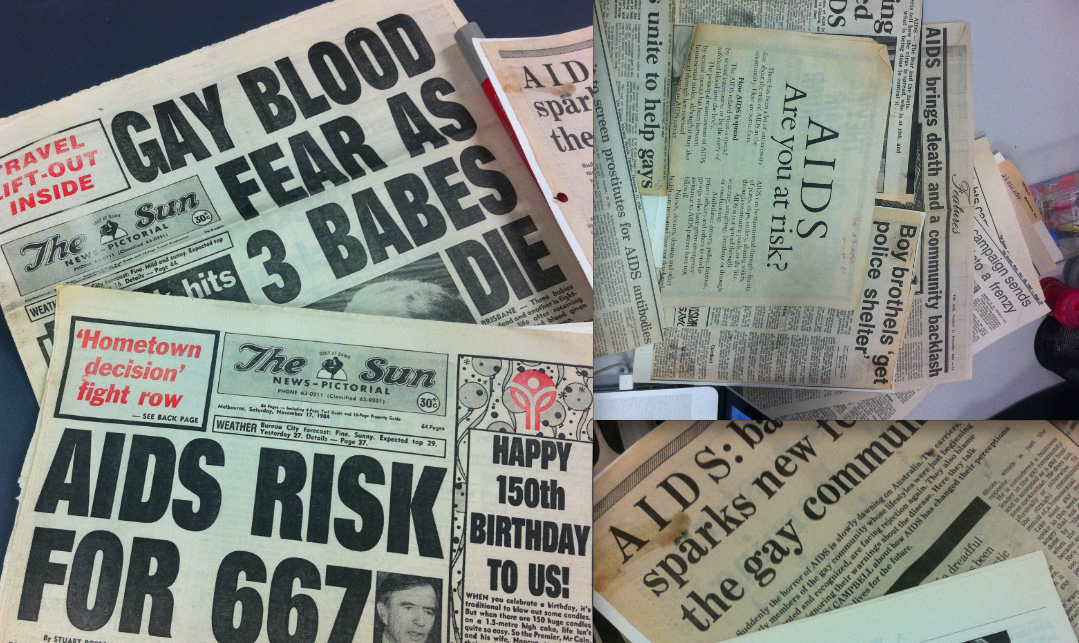
Blood, fear and careless whispers

THINK of the summer of 1984/85 and your mind tends to go to fashion and music. A new singer called Madonna was racing up the charts and George Michael had just had his first solo number one, Careless Whisper, after the demise of Wham!.
Just as Madonna’s sexuality was always discussed but Michael’s sexuality wasn’t by the press, aspects of news stories that related to homosexuality were more than often ignored by the mainstream media.
“THE FAMILY” MURDER(S)
Careless whispers were certainly doing the rounds in Adelaide. Capturing the attention of the whole country, Richard Kelvin, aged 15, had been held captive and brutally murdered in 1983. He was abducted a short distance from his North Adelaide home.
In late 1984 the press devoured every graphic detail of the court case like never before. A Channel 9 60 Minutes TV special dubbed the accused, self-confessed homosexual Bevan Spencer Von Einem and a number of unidentified accomplices as “The Family”. The suggestion was that a number of homosexuals in high places were protecting each other and involved in the deaths of at least five teenagers between 1979 and 1983.
Von Einem was found guilty of the murder and was subsequently the sole person charged with the deaths of two other young men. The case and possible identities of the other alleged “Family” members would continue to be on ongoing source of speculation for years to come. Most striking of all, Don Dunstan, a former South Australia Premier would later sue a newspaper amid claims his silhouette was published among a list of suspects, indicating political payback may have kept “The Family” theory alive.

BLOOD BANK SCANDAL
By late 1984, there had been a few deaths from AIDS-related complications in Australia, with news reports of cases rising dramatically in the US — where AIDS was still largely seen as a “gay disease”. That perception soon changed in the minds of the general public when reports emerged that three babies in Queensland had died of AIDS. Brisbane health officials had linked the reported deaths to blood transfusions connected to a 27-year-old homosexual man. With no accurate blood test available to detect AIDS at the time — some states took extreme measures. Overnight, Queensland laws were changed to fine or jail anyone who was knowingly misleading authorities about giving blood. Western Australia banned all men from donating.
Questions were later asked by some parts of the media about the accuracy of the original reports about the “baby deaths”. The then-Queensland Premier Joh Bjelke–Petersen had made deeply inflammatory comments about homosexuality in the past. According to Dr Peter Harden, the former director of the Brisbane Red Cross Blood Transfusion Service, “only one of the babies had a positive but unconfirmed blood screening for AIDS. One certainly did not die of AIDS and the cause of the other’s death has not been diagnosed”.
The dramatic event became political fodder nationally in the lead-up to the 1984 election on December 1. The then-National leader Ian Sinclair blamed the policies of the Hawke Government for the outbreak of AIDS in Australia — saying the deaths of the babies would not have happened “if Labor policies had not portrayed homosexuality as normal behaviour”.
The Hawke Labor government would hold onto power and responded to the events in a calm and measured fashion. Gay community groups had already been working with state and federal government health departments in NSW and Victoria to fight AIDS. Government ministers dispelled myths and a push was made for more women to donate with full-page adverts taken out to promote it.
With the spotlight on the gay community, media discussion speculated about the motives of some in the gay community. Media commentator Mike Carlton lamented that a “fringe group of homosexuals” may have donated blood “knowing they have it or at possibly out of a warped sense of revenge seeking to take it out on the rest of the community”. It also became clear that closeted men were still giving blood in order to continue hiding their sexuality. Soon even the most conservative commentators were lamenting the difficult choices faced by them. It was recognised too, that homosexual men from across society gave blood because it was screened for hepatitis and syphilis a way of avoiding the judgment of their local doctor.
OUT THERE— CONCLUSION
Gay bars, gay male cruising spots and gay saunas were now being openly debated in newspapers. The relatively-new Reverend Fred Nile called for the closure of all gay saunas in November 1984 after unsuccessfully calling for all gay bars to be closed down in June the previous year. However, now there was acknowledgement of their purpose (and sometimes their merits). While the press interest into the mating rituals of inner-city gay men was often intrusive and judgmental — it probably demystified gay sexuality to large sections of the general public.
Taking it a step further, The Weekend Australian of November 24-25, 1984 openly reported on the backlash the gay community was feeling. There was consensus among those interviewed that governments and the general public only started to care when “those poor babies” died. They observed that domestic coupling was becoming more prominent and more “socialising than sexualising” was happening. Even if that last observation was a bit offensive, we were fortunate to have increasingly media-savvy community leaders and commentators who were able to express what it is like to be gay (well, a gay man at least) to the press. Sadly, this meant highlighting the increase in gay bashings as a result of the AIDS crisis. Visibility, it seems, had come at a price. Times had changed: sexuality was being talked about more and in press and more explicitly in pop culture. There was no better symbol of this new age than the queen of “putting it all out there” Madonna. Australia gave Madonna her first number one ever with Like A Virgin as 1984 came to a close and 1985 began.
You can follow the The Australian Lesbian & Gay Archives on Facebook or visit them online at http://alga.org.au
News headlines from late 1984
NOV 5 – The Sun: “AIDS Link in Blood Agents” — Victorian Health officials contact 40 haemophiliacs who have been given blood products believed to be contaminated with a virus linked to AIDS.
NOV 6 – The Supreme Court jury found Bevan Spencer Von Einem guilty of murdering Richard Kelvin; he was sentenced to 36 years non-parole.
NOV 16 – The Sun: “Gay Blood Fear as 3 Babies Die” — Three babies die and another is fighting for its life after receiving AIDS-suspected blood provided given by a homosexual man
NOV 16 – Herald Vic: “Hawke AIDS Summit” — Prime Minister Bob Hawke calls a health summit on the AIDS threat.
NOV 17 – The Sun: “AIDS risk for 667” – Blood from the homosexual donor linked to the deaths of three Queensland babies has been used to make 667 doses of plasma for Victorian haemophiliacs.

NOV 18 – AIDS Summit of state and federal health ministers
NOV 20 – “Drive For Women To Give Blood Intensifies” Prime Minister’s wife Hazel Hawke donates blood as part of a push for more women donors.
NOV 24 – Sydney Morning Herald: “Rev Nile’s Wrath Descends on Saunas” – A handful of Festival of Light supporters lead by Rev Fred Nile protest outside gay sauna on Oxford St demanding its closure.
NOV 25 – Sunday Telegraph: “AIDS Man May Sue For Damages” – Australia’s first AIDS victim through a blood transfusion confirms he is seeking legal advice about suing the NSW Government
DEC 2 – Sunday Press – “GPs Unite To Help Gays” – reports the formation of the Australian Gay Medicine Association consisting of more the 40 doctors
DEC 10 – Courier Mail – “The Men of Evil Who Prey on Children” – Undercover operation by newspaper into implicates police in underage prostitution.
_____________________________________________________
AIDS IN AUSTRALIA – from The Weekend Australian (NOV 17-18, 1984)
National Health and Medical Research Council (NHMRC)
Deaths: 9; Suspected: 3
Confirmed Cases (inc. deaths): 24
Transfusion of suspected contaminated blood (42) or blood products (40): 82










It is important that we remember this history and learn what we can from it.
Live through this…and we did.
I remember my nan who I was living with talking to me about it Awful time hopefully this helps others remember the road travelled as sad as it is
This was a terrible time in the UK-people were terrified, the LGBT community were being physically attacked. Horrible to see this style of reporting being relived.
Horrible memories come flooding back when I read this….it was such a frightening time to be a young gay man.
You are an amazing, big hearted guy, and I am so proud to call you my friend, and I am happy beyond description, that you are safe, alive, and healthy, and that those awful times did not break you, along with other friends from way back when.
Thanks Jayne. I appreciate your words more than you could imagine. We’ll always be great friends, it was just meant to be. Xx
I don’t know what’s more shocking, the fact I remember this or the fact I was diagnosed poz 10 yrs later, I did like most people did, I guess, thought “Oh this won’t affect me”, that would have been the time I really wanted crystal balls.
I’m surprised anybody would want to relive probably the lowest ever point in Australian journalism. Many people still have deep psychological scars all these years later because of the media’s handling of the AIDS issue in the 1980s. We will probably never know exactly how many nervous breakdowns and suicides were caused by this disgusting journalistic frenzy.
its true there was some terrible journalism in the mainstream media. But some amazing efforts by gay journalists like Adam Carr saved lives.
Yet 1984 was the year homosexuality was decriminalized in NSW. Lest we forget.
For younger people, this is a snapshot of media in the 80’s..